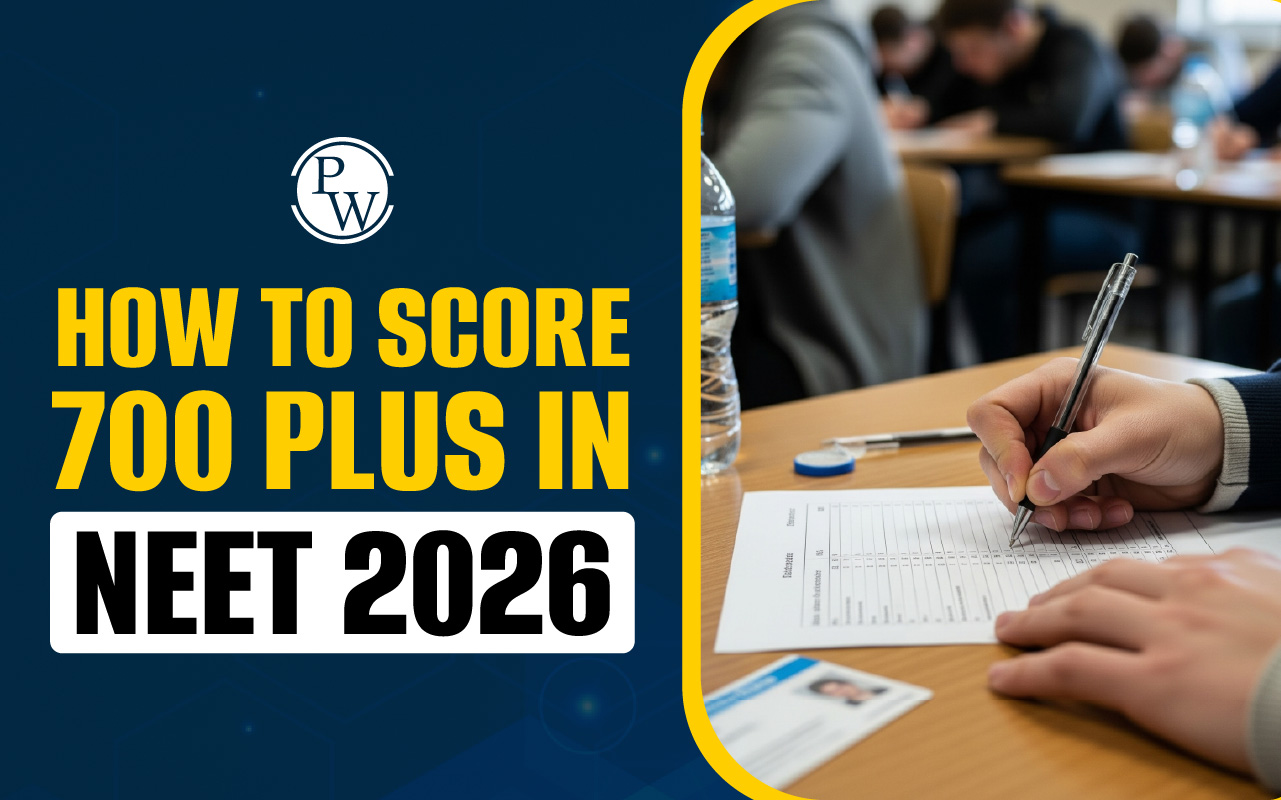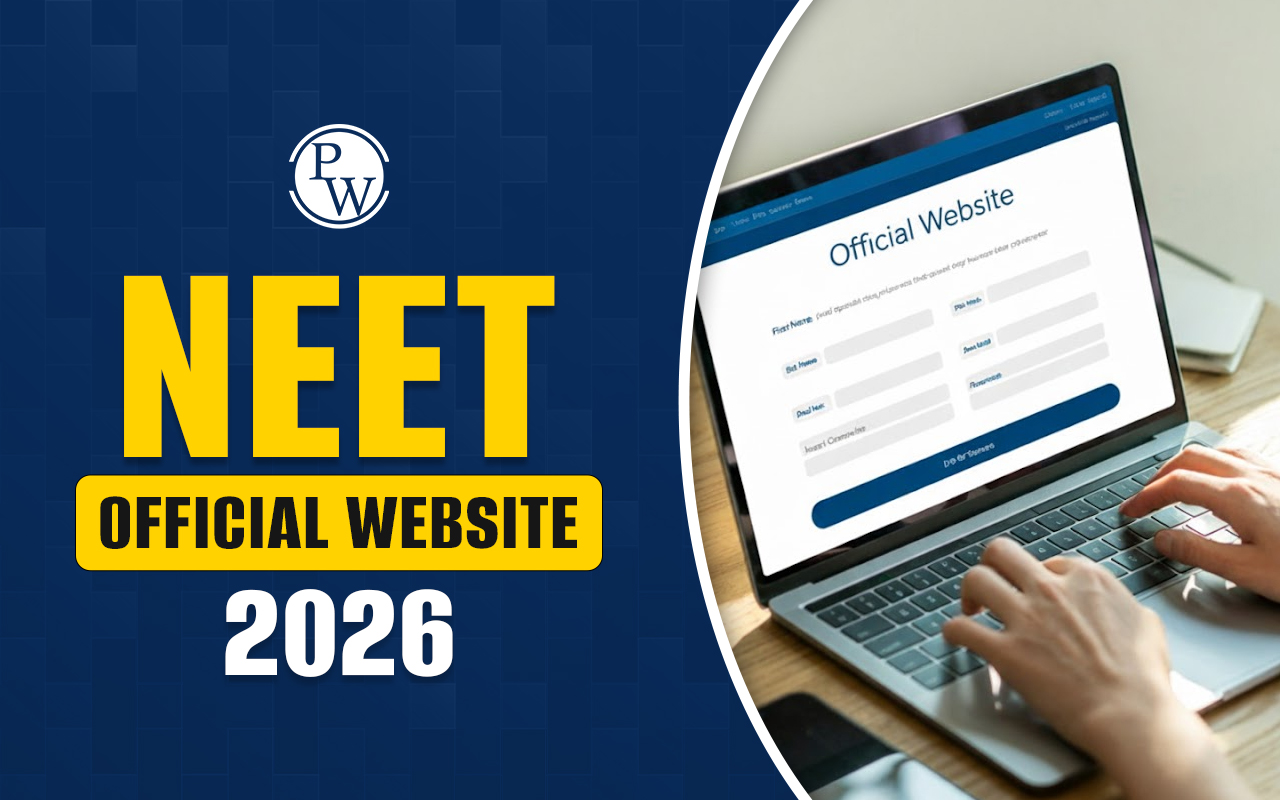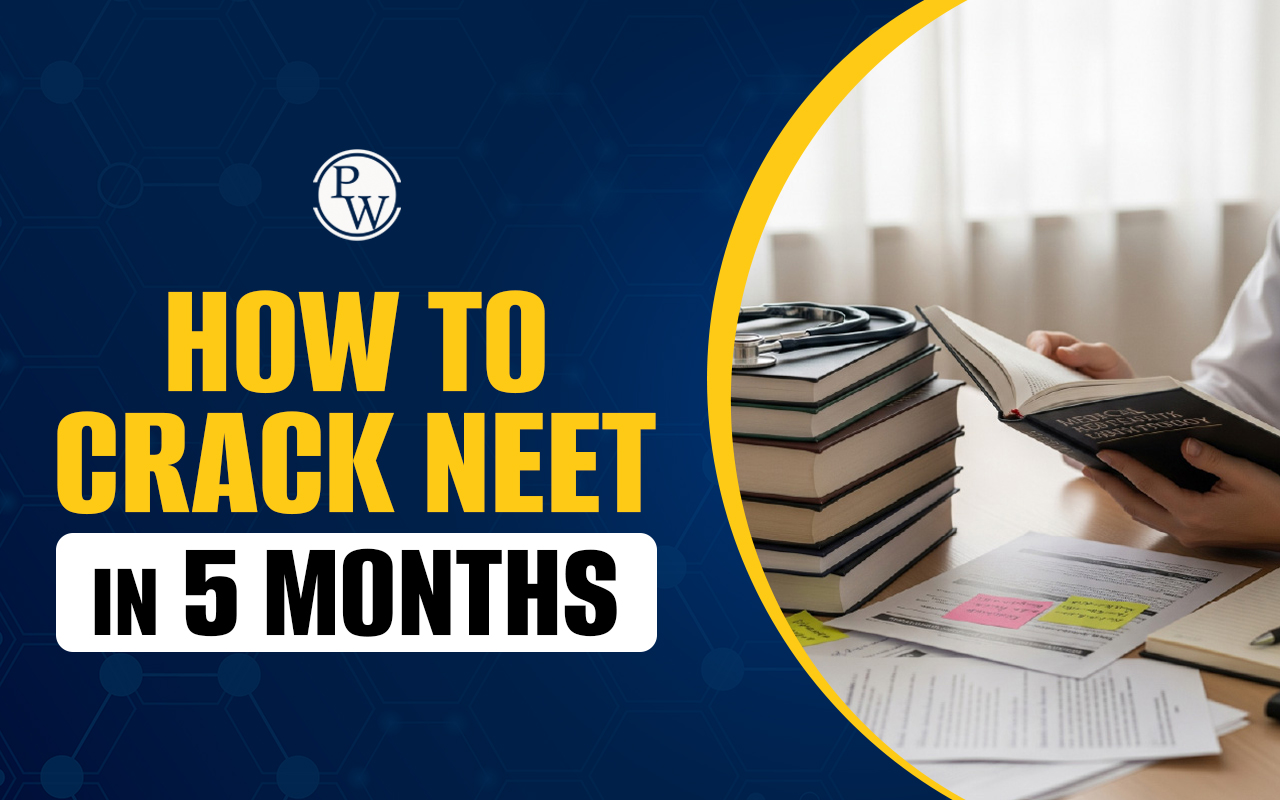
Current Electricity MCQs: Current Electricity MCQs are created to test your understanding of how electric charge flows through conductors. These questions cover topics such as the relationship between voltage, current, and resistance, and how electrical circuits behave under different conditions.
Practicing these questions helps strengthen your knowledge, improve problem-solving skills, and prepare well for exams. Students who want to practice Current Electricity MCQs can refer to the article below. These questions have been designed by experts based on the types of questions commonly found in the NEET exam.Current Electricity MCQs for NEET
For NEET preparation, Current Electricity MCQs are a key part of the NEET Physics syllabus . These questions test students’ understanding of electric current, circuits, and resistance. They often involve complex problems and require a deep knowledge of the subject. Practicing these NEET-specific MCQs helps students get used to the format and difficulty of the exam questions. This practice is essential for achieving a high score and performing well in the Physics section of NEET. Additionally, this chapter carries high NEET Physics chapter-wise weightage , highlighting its importance in the exam and making it a scoring chapter.
Current Electricity MCQs with Answers
Current Electricity MCQs with answers offer a useful resource for students to review their performance. Each question is followed by an answer, which helps clarify the correct response and address any misunderstandings. Reviewing these answers allows students to understand the reasoning behind each solution, enhance their problem-solving skills, and build confidence in their knowledge of current electricity.| NEET Physics MCQs | |
|---|---|
| Units and Measurements MCQs | Motion in a plane MCQs |
| Mathematics Tools MCQs | Newton’s laws of motion MCQs |
| Motion in a straight line MCQs | Gravitation MCQs |
Q 1. Electric current has both magnitude and direction. It is a;
(1) Vector quantity (2) Scalar quantity (3) Tensor quantity (4) None of these Ans: 2Q 2. The rate of flow of electric charges through any cross-section of a conductor is known as
(1) Electric flux (2) Electric potential (3) Electric current (4) Electric field Ans: 3Q 3. Across a metallic conductor of non-uniform cross-section a constant potential difference is applied. The quantity which remains constant along the conductor is;
(1) Current (2) Drift velocity (3) Electric field (4) Current density Ans: 1Q 4. A wire has a non-uniform cross-sectional area as shown in the figure. A steady current flows through it. Which one of the following statements is correct
 (1) The drift speed of the electron is constant
(2) The drift speed increases on moving from A to B
(3) The drift speed decreases on moving from A to B
(4) The drift speed varies randomly
Ans: 3
(1) The drift speed of the electron is constant
(2) The drift speed increases on moving from A to B
(3) The drift speed decreases on moving from A to B
(4) The drift speed varies randomly
Ans: 3
Q 5. Statement I: The drift velocity of an electron is doubled if the electric field applied across the conductor is doubled.
Statement II: The drift velocity of an electron is directly proportional to the electric field applied across the conductor.
(1) Statement-I and Statement-II both are correct. (2) Statement I is correct but Statement II is incorrect. (3) Statement I is incorrect but Statement II is correct. (4) Statement-I and Statement-II both are incorrect. Ans: 1 Q 6. A potential difference of V is applied at the ends of a copper wire of length l and diameter d. On doubling only d, drift velocity (1) Becomes two times (2) Becomes half (3) Does not change (4) Becomes one fourth Ans: 3 Q 7. A current flows in a wire of circular cross-section with the free electrons traveling with a mean drift velocity v. If an equal current flows in a wire of twice the radius new mean drift velocity is; (1) v (2) v/2 (3) v/4 (4) None of these Ans: 3Q 7. Two wires A and B of the same material, having radii in the ratio 1:2 and carry currents in the ratio 4:1. The ratio of drift speeds of electrons in A and B is;
(1) 16:1 (2) 1:16 (3) 1:4 (4) 4:1 Ans: 1Q 8. A current flows through a uniform wire of diameter d when the mean drift velocity is V. The same current will flow through a wire of diameter d/2 made of the same material if the mean drift velocity of the electron is;
(1) V/4 (2) V/2 (3) 4V (4) 2V Ans: 3Q 9. Assertion (A): Current and time both have direction as well as magnitude but still are not considered vectors.
Reason (R): They do not follow the laws of vector addition.
(1) Both Assertion (A) and Reason (R) are true and Reason (R) is a correct explanation of Assertion (A). (2) Both Assertion (A) and Reason (R) are true but Reason (R) is not a correct explanation of Assertion (A). (3) Assertion (A) is true, and Reason (R) is false. (4) Assertion (A) is false, and Reason (R) is true. Ans: 1Q 10. Assertion (A): The drift velocity of electrons in a conductor is very small when its two ends are connected to a battery.
Reason (R): It is because, as the electrons accelerate, they get deflected on suffering collisions against the positive ions in the conductor.
(1) Both Assertion (A) and Reason (R) are true and Reason ® is a correct explanation of Assertion (A). (2) Both Assertion (A) and Reason (R) are true but Reason (R) is not a correct explanation of Assertion (A) (3) Assertion (A) is true, and Reason (R) is false. (4) Assertion (A) is false, and Reason (R) is true. Ans: 2Q 11. The current passing through a conductor is 5 ampere. The charge that passes through that conductor in 5 minutes is;
(1) 1200 C (2) 300 C (3) 1000 C (4) 1500 C Ans: 4Q 12. Ohm's law is true.
(1) For metallic conductors at constant temperature. (2) For metallic conductors at variable temperatures. (3) For electrolytes when current passes through them. (4) For diode when current flows. Ans: 1Q 13. The masses of three wires of copper are in the ratio of 1 : 3: 5 and their lengths are in the ratio of 5 : 3: 1 The ratio of their electrical resistances is;
(1) 5 : 3: 1 (2) 1 : 3: 5 (3) 1: 15: 125 (4) 125: 15: 1 Ans: 4 Q 14. Three copper wires of length and cross-sectional area (L, A), (2L, A/2), and (L/2, 2A). Resistance is minimal in; (1) Wire of cross-sectional area A (2) Wire of area A/2 (3) Wire of cross-sectional area 2A (4) Same in all three cases Ans: 3Q 15. A Wire of 1Ω has a length of 1m. It is stretched till its length increases by 25%. The percentage change in resistance to the nearest integer is;
(1) 76% (2) 56% (3) 12.5% (4) 25% Ans: 2Q 16. A wire of a certain material is stretched slowly by 10%. Its new resistance and specific resistance become respectively:
(1) 1.2 times, 1.3 times (2) 1.21 times, same (3) both remain the same (4) 1.1 times, 1.1 times Ans: 2 Q 17. An aluminum wire is stretched to make its length, 0.4% larger. The percentage change in resistance is; (1) 0.4 % (2) 0.2 % (3) 0.8 % (4) 0.6 % Ans: 3Q 18. A copper wire is stretched to make it 0.5% longer. The percentage change in its electrical resistance if its volume remains unchanged is;
(1) 2.0% (2) 2.5% (3) 1.0% (4) 0.5% Ans: 3 Q 19. A wire of resistance R1 is drawn out so that its length is increased by twice of its original length. The ratio of new resistance to original resistance is; (1) 9: 1 (2) 1: 9 (3) 4: 1 (4) 3: 1 Ans: 1Q 20. A wire of resistance 4Ω is stretched to twice its original length. The resistance of a stretched wire would be;
(1) 4Ω (2) 8Ω (3) 16Ω (4) 2Ω Ans: 3Q 21. Statement-I: When a wire is not connected to the battery, then no current flow.
Statement II: Electrons move randomly or do not move in a particular direction
(1) Statement-I and Statement-II both are correct. (2) Statement I is correct but Statement II is incorrect. (3) Statement I is incorrect but Statement II is correct (4) Statement-I and Statement-II both are incorrect. Ans: 1Q 22. Statement-I: Ohm’s law is applicable to all conductors of electricity including diodes
Statement II: In an electrolytic solution, the electric current is mainly due to the movement of free electrons.
(1) Statement-I and Statement-II both are correct. (2) Statement I is correct but Statement II is incorrect. (3) Statement I is incorrect but Statement II is correct (4) Statement-I and Statement-II both are incorrect. Ans: 2Q 23. Statement-I: In a simple battery circuit the point of lowest potential is the negative terminal of the battery.
Statement II: The current flows towards the point of the higher potential as it flows in such a circuit from the negative to the positive terminal.
(1) Statement-I and Statement-II both are correct. (2) Statement I is correct but Statement II is incorrect. (3) Statement I is incorrect but Statement II is correct. (4) Statement-I and Statement-II both are incorrect. Ans: 2Q 24. Assertion (A): Bending a wire does not affect electrical resistance.
Reason (R): The resistance of a wire is proportional to the resistivity of the material.
(1) Both Assertion (A) and Reason (R) are true and Reason (R) is a correct explanation of Assertion (A). (2) Both Assertion (A) and Reason (R) are true but Reason (R) is not a correct explanation of Assertion (A). (3) Assertion (A) is true, and Reason (R) is false. (4) Assertion (A) is false, and Reason (R) is true. Ans: 2Q 25. Assertion (A): The direction of the current can't be from negative potential to positive in an electric circuit outside the battery.
Reason (R): The direction of the current is opposite to the flow of electrons.
(1) Both Assertion (A) and Reason (R) are true and Reason (R) is a correct explanation of Assertion (A). (2) Both Assertion (A) and Reason (R) are true but Reason (R) is not a correct explanation of Assertion (A). (3) Assertion (A) is true, and Reason (R) is false. (4) Assertion (A) is false, and Reason (R) is true. Ans: 4Q 26. The length of the given cylindrical wire is increased by 100%. Due to the consequent decrease in diameter, the change in the resistance of the wire will be;
(1) 200% (2) 100% (3) 50% (4) 300% Ans: 4Q 27. Two copper wires are of the same length one of the wires is twice as thick as the other. Then the resistance of the two wires is in the ratio of;
(1) 1: 16 (2) 1: 8 (3) 1: 4 (4) 1: 2 Ans: 3Q 28. Two wires have their lengths in the ratio 1 : 3, diameters in the ratio 2 : 3, and their materials have specific resistances in the ratio 2: 1. Then the ratio of their resistance is;
(1) 1: 3 (2) 3: 1 (3) 2 : 3 (4) 3: 2 Ans: 4 Q 29. Two wires made of the same material have lengths in the ratio 1: 2 and their volumes are the same. The ratio of their resistance is; (1) 4: 1 (2) 2: 1 (3) 1: 2 (4) 1: 4 Ans: 4Q 30. The temperature coefficient of resistance for a wire is 0.00125/ oC. At 300 K its resistance is 1 ohm. The temperature at which the resistance becomes 2 Ohm is;
(1) 1154 K (2) 1100 K (3) 1400 K (4) 1127 K Ans: 4Q 31. If the resistance of a conductor is 5Ω at 50o C and 7Ω at 100o C then the mean temperature coefficient of resistance of the material is;
(1) 0.008/ oC (2) 0.006/ oC (3) 0.004/ o C (4) 0.013/ o C Ans: 4Q 32. The resistance of a conductor is 5Ω at 50o C and 6Ω at 100o C. Its resistance at 0o C is;
(1) 1 ohm (2) 2 ohm (3) 3 ohm (4) 4 ohm Ans: 4Q 33. The resistance of a wire at 20o C is 20Ω and at 500o C is 60Ω. At what temperature its resistance is 25Ω;
(1) 160o C (2) 250o C (3) 100o C (4) 80o C Ans: 4Q 34. As the temperature increases, the electrical resistance:
(1) decreases for both conductors and semiconductors (2) increases for conductors but decreases for semiconductors (3) decreases for conductors but increases for semiconductors (4) increases for both conductors and semiconductors. Ans: 2Q 35. The solids which have the negative temperature coefficient of resistance are;
(1) insulators only (2) semiconductors only (3) insulators and semiconductors (4) metals Ans: 3Q 36. The resistivity (specific resistance) of a copper wire;
(1) increases with an increase in its temperature. (2) decreases with increase in its cross-section. (3) increases with an increase in its length. (4) increases with an increase in its cross-section. Ans: 1Q 37. Si and Cu are cooled to a temperature of 300 K, then resistivity?
(1) For Si increases and for Cu decreases (2) For Cu increases and for Si decreases (3) Decreases for both Si and Cu (4) Increases for both Si and Cu Ans: 1Q 38. Lamps used for household lighting are connected in;
(1) series (2) parallel (3) mixed circuit (4) none of the above combinations Ans: 2Q 39. If you are provided a set of resistances 2Ω, 4Ω, 6Ω, and 8Ω. Connect these resistances so as to obtain an equivalent resistance of 46/3 Ω.
(1) 4Ω and 6Ω are in parallel with 2Ω and 8Ω in series (2) 6Ω and 8Ω are in parallel with 2Ω and 4Ω in series (3) 2Ω and 6Ω are in parallel with 4Ω and 8Ω in series (4) 2Ω and 4Ω are in parallel with 6Ω and 8Ω in series Ans: 4Q 40. A wire of resistance R is bent to form a square ABCD as shown in the figure. The effective resistance between E and C is; (E is the mid-point of arm CD)
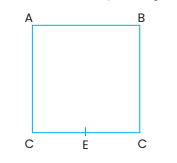 (1) R
(2) (7/64)R
(3) (3/4) R
(4) (1/16) R
Ans: 2
(1) R
(2) (7/64)R
(3) (3/4) R
(4) (1/16) R
Ans: 2
Q 41. What will be the equivalent resistance between the two points A and D?
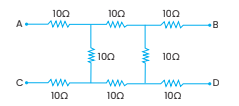 (1) 10Ω
(2) 20Ω
(3) 30Ω
(4) 40Ω
Ans: 3
(1) 10Ω
(2) 20Ω
(3) 30Ω
(4) 40Ω
Ans: 3
Q 42. The equivalent resistance of the arrangement of resistances shown in the adjoining figure between points A and B is;
 (1) 6 ohm
(2) 8 ohm
(3) 16 ohm
(4) 24 ohm
Ans: 2
(1) 6 ohm
(2) 8 ohm
(3) 16 ohm
(4) 24 ohm
Ans: 2
Q 43. The equivalent resistance of the given circuit between the terminal A and B is;
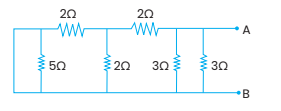 (1) 0Ω
(2) 3Ω
(3) 9/2Ω
(4) 1Ω
Ans: 4
(1) 0Ω
(2) 3Ω
(3) 9/2Ω
(4) 1Ω
Ans: 4
Q 44. Statement-I: The coefficient of resistivity of carbon is negative.
Statement II: The resistance of an incandescent bulb is greater when the bulb is switched on.
(1) Statement I and Statement II both are correct. (2) Statement I is correct but Statement II is incorrect (3) Statement I is incorrect but Statement II is correct (4) Statement-I and Statement-II both are incorrect. Ans: 1Q 1. Statement-I: The temperature coefficient of resistance is positive for metals and negative for P-type semiconductors.
Statement II: The effective charge carriers in metals are negatively charged whereas in P-type semiconductors they are positively charged
(1) Statement I and Statement II both are correct. (2) Statement is correct but Statement II is incorrect (3) Statement I is incorrect but Statement II is correct (4) Statement I and Statement II both are incorrect. Ans: 1What is the best way to approach Current Electricity MCQs?
To approach Current Electricity MCQs effectively:- Read Carefully : Pay attention to the details of each question.
- Apply Concepts : Use your knowledge of current electricity principles to solve problems.
- Practice Time Management : Work on answering questions within a set time limit to enhance exam performance.
- Analyze Mistakes : Learn from incorrect answers to avoid repeating mistakes in the future.
Current Electricity MCQs FAQs
Q. What are Current Electricity MCQs Questions Class 12?
Q. Why should I practice MCQs on Current Electricity?
Q. How are Current Electricity MCQs for NEET different from Class 12 MCQs?
Q. How can Current Electricity MCQs Tests aid in my exam preparation?
Q. What benefits do Current Electricity MCQs with Answers offer?
Q. What should I focus on while practicing Current Electricity MCQs?

